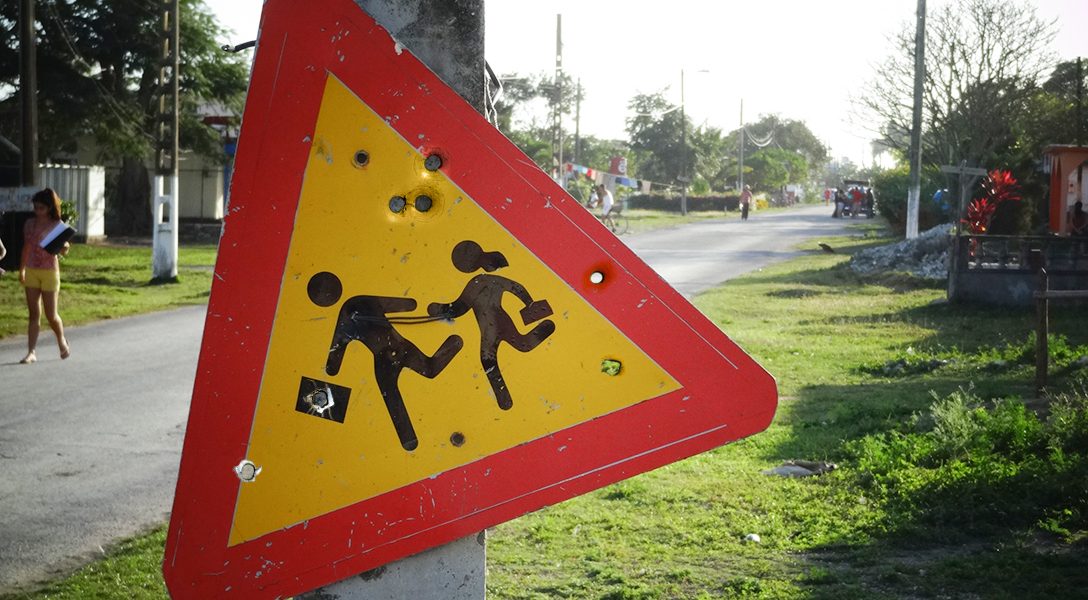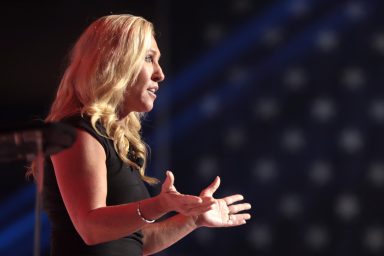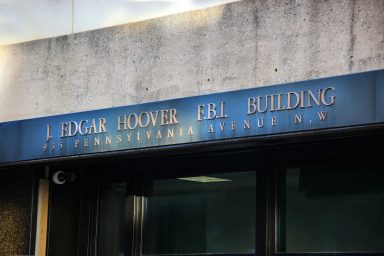The media and the public focus on the school shootings that resulted in fatalities and casualties. However, many potential massacres are headed off by savvy interventions. What can we learn from those?
What about all of the school shootings that have been averted?
With new investigative research, and an emphasis on prevention and collaboration, we are now in a better position to understand school violence from the perspective of school personnel who have actually headed off deadly shootings.
So says Dr. Jeff Daniels, a professor at the University of West Virginia, who has been working to identify pre-attack behavior. His team has studied 37 school shootings, involving 41 attackers.
In this week’s WhoWhatWhy podcast he talks with Jeff Schechtman about some of his findings. They include the fact that attacks were rarely sudden. Attackers always seemed to go through a similar process in the weeks and months leading up to a shooting. In many cases, other people knew about the attacker’s mind-set, but too often they did not share their concerns because the negative connotation of “snitching” came into play.
In the end, what a shooter did and said leading up to the attack seemed to be a more precise predictor than any long-term personal history. Often, the shooters came from intact families, but some came from broken homes. Some had difficulty coping with significant losses or personal failures. Many felt bullied or persecuted and had considered or attempted suicide.
In contrast to the diversity of these psychological portraits, Daniels explains how similar behavior in the run-up to the shootings offers a stronger basis for intervention than the confusing data from personal profiling.
It’s research that law enforcement and schools need to take heed of.
Click HERE to Download Mp3
Full Text Transcript:
As a service to our readers, we provide transcripts with our podcasts. We try to ensure that these transcripts do not include errors. However, due to time constraints, we are not always able to proofread them as closely as we would like. Should you spot any errors, we’d be grateful if you would notify us.
| Jeff Schechtman: | Welcome to Radio WhoWhatWhy, I’m Jeff Schechtman. There is no question that the easy availability of guns, especially assault weapons, has contributed in some way to the rash of school shootings. However, we would be naïve to think that this is the totality of the problem. Beyond guns, the broader questions always should be how these shootings can be averted. How can we understand and interpret the data from so many past events in ways that help us to prevent the next? |
| In a world where big data is becoming the holy grail, can data be used to keep our students safe? To discuss this I’m joined by Jeff Daniels. He’s a Professor of Counseling at West Virginia University and his work in research on averting school shootings is groundbreaking. His recent article in the academic journal The Conversation is entitled “If You Want To Know How To Stop School Shootings, Ask The Secret Service.” It is my pleasure to welcome Jeff Daniels to Radio WhoWhatWhy. Jeff, thanks so much for joining us. | |
| Dr. Jeff Daniels: | My pleasure and thank you for inviting me. |
| Jeff Schechtman: | It’s interesting, and you’ve been looking at these things for a long time, that we never really stop to think about the profiles of school shooters, and what we can learn from all the past events, and how we can use that data, use that information to avert these things. Yet, as you point out with respect to the Secret Service in particular, and law enforcement in general, they use these techniques all the time. |
| Dr. Jeff Daniels: | Right. I think when we start talking about profiling, there’s obviously a lot of moral and even legal issues around that, but one of the main findings that the Secret Service found is that there really is no useful profile-based school shooter. I think the main thing is across multiple school shooters, there’s often warning signs or warning behaviors, changes in behavior, things that we can look for that alter from the student’s baseline behavior. I guess rather than profiling, it’s being able to recognize when a student has some kind of a change in their behavior. |
| Jeff Schechtman: | What are the specific things that history and data, and even the Secret Service tell us we should be looking for? |
| Dr. Jeff Daniels: | Well, oftentimes students that have been school shooters in the past, they may have a change in their academic performance. They may have been an A, B student, and suddenly their grades are plummeting. There may be changes in their physical appearance, perhaps, less detail to physical grooming, and these sorts of things. There may also be kind of a major event in the student’s life that is related to this, for lack of a better word, decompensation. For instance, a lot of students who became school shooters had some kind of a crisis or event in their life months leading up to the event, perhaps a parental divorce. In the case of the Florida shooter, we see that his mother passed away two months before he went on the shooting spree. |
| It may be a breakup with a significant other. These sorts of things seem to be common across many of the school shooters. | |
| Jeff Schechtman: | Talk a little bit about the research, the studies that have been done, some of which you reference in your recent article. |
| Dr. Jeff Daniels: | Yeah. So following Columbine, there was a big push to try to understand the school shooter phenomenon. There were two primary studies that were done. I referenced this study that was done … it was a combination of the US Secret Service and the US Department of Education. The Secret Service became involved, because they’re experts at threat assessment. They’re experts at recognizing if somebody poses a risk or a danger. So they partnered up and they interviewed 41 school shooters that had been involved with 37 incidents. They also gathered quite a bit of background data from each of these students in the incidents, including news reports, where available psychological evaluations, and all of these sorts of things. |
| At about the same time, the Federal Bureau of Investigation, the Behavior Analysis Unit in particular, Mary Ellen O’Toole did a similar study, where she went in, and she interviewed school shooters that were incarcerated, and also gathered as much background information as she could. From both of these studies, we find fairly parallel findings. When I became interested in this … I grew up in Jefferson County, Colorado which is, as probably many people recognize, where Columbine took place. My interest was in the school shooter phenomenon, but in the early 2000s, with these two projects ongoing, the piece that I found that was missing is there was no research into the averted incidents. | |
| So I started … I got a small ranch, and went to small schools that had intervened through prevented shootings/bombing attacks on their school. I wanted to include only serious and credible situations. So some student just out of frustration saying, “I’m gonna kill you,” is not a credible threat. For the schools that I went to, there was enough evidence for a conviction. So I believed that was a pretty good indicator that these were serious and credible threats. Then I interviewed all of the adults, who were involved in discovering the plot, and then intervening to prevent it. | |
| Jeff Schechtman: | Talk a little bit about some of the things that you found, some of the consistencies that you found. It’s almost as if there was a process that took place in some cases. |
| Dr. Jeff Daniels: | Exactly. Our primary finding that every person that we interviewed talked about is an area that we just term ‘school conditions’. These are things that the school, the administration, the staff set up to try to promote a good learning environment, as well as try to break a code of silence. Just briefly, The Code of Silence was one of the findings from the FBI study. In over 80% of the school shooting incidents, somebody knew in advance that there was going to be a shooting, or something bad was going to happen, but they didn’t report their concerns. So this was termed The Code of Silence. |
| And there’s probably three primary reasons why this exists. I think students either didn’t take the threat seriously, or two, they didn’t know to whom they could turn. They weren’t sure which person they could tell, so they told nobody. Or three, they didn’t want to be seen as a rat or a snitch. So in schools that averted a shooting, there were specific efforts that were made to try to break this Code of Silence. A lot of that comes down to forming relationships with students, and trying to have students feel like there’s at least one adult at the school that they can go and they can report concerns to. | |
| One school that I went to included efforts to kind of make a distinction for students between snitching, which is telling on somebody, they get them in trouble, and being helpful, which is telling, because you’re worried or concerned about them. So these are the sorts of thing that were involved with school conditions. | |
| Jeff Schechtman: | One of the things that you point out is that while many of the stories that surround school shooters after they perpetrate a crime, portray them as loners. The fact is that many cases, they’ve talked to people, they’ve told somebody information that might have been useful in finding out what might be happening. |
| Dr. Jeff Daniels: | Especially now. So when these studies were done back in the late ’90s, early 2000s, social media wasn’t up and running as it is today. I think especially today, we see a lot of social media chatter, events, and there have been quite a few school shootings that have been averted, because the individual would post something on social media. Now we know about Cruz that he had quite a bit of social media presence, where he even identified himself as designing to be a professional school shooter. |
| So there are these blatant communications that often go out before an event happens, and then there’s also some subtle communications that go out that the FBI study referred to as “leakage.” In leakage, this is where the individual communicates intent indirectly. So for instance, Seung-Hui Cho from Virginia Tech, his English professor turned him in, because she was growing concerned about increasingly violent writings that he was doing for class projects. According to a book written by Cullen on Columbine, Eric Harris and Dylan Klebold the year before had done a school project, where they created a video of them going on a shooting spree in their school. This was for a class assignment. So these sorts of things that were referred to as leakage tend to come out as well. | |
| Jeff Schechtman: | Talk a little bit about the planning that goes into some of these shootings, and also the information that leaks out from those planning efforts in many cases. |
| Dr. Jeff Daniels: | Yeah. In many situations, this was a common finding across the Secret Service study was that, kind of their conclusion was that these students don’t just snap. This is the end result of a long process of planning. So there’s kind of a three-phase process. It goes from having a grievance of some sort, and starting to fantasize about doing something about it. At some point that then moves to the planning phase. This is where the student may begin acquiring weapons, it may be trying to recruit somebody to help them in this process. This is a good place for intervention, because many of the schools that have averted a shooting it’s been during this phase that somebody would come forward, and say, “This person’s trying to recruit me to help in a school shooting.” |
| And they’re able to investigate and intervene before it happens. Then the third phase is obviously the action phase. At some point that plan comes to fruition if it hasn’t been averted until then, and it’s the actual implementation of that long line of thinking and planning. | |
| Jeff Schechtman: | What has to change in the culture of schools to make this information more readily available? What are the schools that have had success with this? And the ones that have been really active in trying to cause this information to come to the surface more quickly and more publicly, what have they done? |
| Dr. Jeff Daniels: | Well, I think one of the things that we found in our research was the importance of having interpersonal relationships with students. One principal in a very large suburban high school, I’ll paraphrase him, but he told me that, “It’s inexcusable that any student in my school isn’t known by us.” So one of the things that they do actively to try to develop these relationships is teachers eat with the students. At every single table in the cafeteria is a teacher. He said, “You would be amazed at the kinds of things that the students tell them once they get to know them just beyond being a teacher.” |
| Another school that I went to, the principal said that he implemented a policy that, “Every teacher is to compliment every student every day. Just notice something about them, and pay them a compliment.” These are fairly simple things. He said some of these are even fairly minimal compliments. It may be as simple as, “Thank you for not falling asleep in class today.” It lets the students know that somebody is attending to them, and knows that they’re there. I think in one other school, and this was actually a study that I did on school hostage takings that were successfully resolved. | |
| But for that school, during all the movement times, so between classes, before school starts, during lunch, all of the teachers are asked to be out in the hallways, and they’re doing two things. A, they’re monitoring, which communicates to the students that I can’t get away with anything, or for the other students that I’m safe. But B, they’re talking to the students as they go by, and they’re asking about, “How’s that issue we were talking about the other day?” Just these sorts of things. | |
| So the students feel like there’s somebody there that knows them and cares about them. I think another one of the things that we found across schools were active efforts to try to prevent bullying. So that’s treating all students with dignity and respect, it’s when somebody comes forward, and says, “Either I’m being bullied or harassed,” or somebody else comes and says, “I see that Johnny is being bullied.” The adults in the school take some proactive steps on that, rather than either ignoring it, or maybe even giving bad advice to the student. But actually going forward, and helping that student to resolve the problem. | |
| Jeff Schechtman: | Given the important role that the teachers play in this paradigm that you’re laying out, to what extent do you think that this would be impacted by the students knowing that the teachers were armed, for example? |
| Dr. Jeff Daniels: | I think for some students that would probably put up a barrier. I think some students are going to be very concerned about that, and they’re not going to want to be too close to that teacher. I think for other students, it may convey a sense of safety and security, but whether or not arming teachers would be an effective strategy, there’s lots of opinions out there on that, but not a whole lot of data. |
| Jeff Schechtman: | I guess the question is the difference between teachers being armed if an incident happens, versus the negative impact of armed teachers in ways that can prevent or avert one of these incidents from taking place at all. |
| Dr. Jeff Daniels: | Yeah. I think one of the things that was clear after Columbine was that schools started to feel a little bit like prisons. A lot of schools bought metal detectors. They had zero tolerance policies. The schools rightly were locked, so that intruders or external people couldn’t get in. But I think that that took a toll on educational morale, these sorts of things. I think if we arm teachers, that’s going to continue this notion that schools are A, schools are very dangerous, and B, they’re kind of prison-ish. And just a word on that dangerousness. There’s been a lot of research that’s been conducted that’s looked at the fact that schools continue to be the safest place for our kids. |
| These mass shootings attract a lot of attention. They’re horrific, they’re traumatic. But statistically, children are still much less likely to be killed at school than they are outside of school. So in some ways it’s a perception that no school is safe. If we arm every teacher, that’s kind of feeding into that perception. | |
| Jeff Schechtman: | With respect to kids coming forth with information, what do you see the data telling us with respect to gender differences? Are girls, for example, better listeners? Are they more willing to come forth? Do they have a better sense of the emotional upheaval of their classmates? |
| Dr. Jeff Daniels: | I don’t know of any data on that. Actually, I’m working right now with a police foundation. We’re developing a database of averted school shootings. That would be an interesting variable to look at is, what is the gender of the person that came forward with information? I think anecdotally, I see that’s perhaps about 50/50, but I haven’t really looked deeply into that question. |
| Jeff Schechtman: | In the article, you talk about some of the things we can learn from the Secret Service. Talk a little bit more about that. And what we learn from their talents and skills that they bring to these kinds of issues. |
| Dr. Jeff Daniel: | Number one, these are rarely sudden, impulsive attacks, and most people knew about the attacker’s intentions before it occurred. So the implication of that, of course, is that we need to get better at listening, and forming the kinds of relationships that students will tell us what’s going on. We talked a bit about the main finding of either leakage, or communicating outright their intentions. I think that one is an important finding, because when schools avert a shooting, they’re taking all rumors seriously, and they’re acting upon that. |
| We haven’t talked a whole lot about that most of the attackers felt bullied or persecuted in some way, and that’s an important issue. I think that we can’t overlook the fact that there are still a lot of cases in schools, where students are being persecuted, they’re being bullied, they’re being picked on. Now, not all school shooters have been bullied, and obviously, not all bullies become school shooters. So research has found that there’s really a couple types of bullies. There’s the aggressive bullies, who are kind of what we typically think of. There’s also victim bullies. These are students, who are being victimized themselves, but then in turn, they go around and they bully someone else. | |
| Then there’s now a more recent social bullying, which is kind of what we see in social media. It may be spreading false rumors about somebody, and these sorts of things. So these issues really need to continue to be dealt with. | |
| Jeff Schechtman: | Would it make a difference based upon your studies and your research, if schools, particularly larger ones, and particularly really large high schools began to hire an individual, whose job was dedicated to monitoring these kinds of behaviors in at-risk kids? |
| Dr. Jeff Daniels: | I don’t know that they necessarily need to hire somebody. I think existing personnel can do that fairly effectively. I think teachers, who have daily contact with students, I think if they know what to look for, they can be effective. I think an underutilized resource that all schools have is the school counselor. Often, especially in high schools, and in larger schools, unfortunately, school counselors who are trained mental health providers are being used to help students with career issues, trying to find scholarships, maybe even doing the scheduling for the school. |
| I think school counselors really are trained to be able to look for these sorts of things, and then intervene. So maybe educating school administrators about the roles and functions that school counselors, as well as school psychologists, can play in preventing these sorts of events. | |
| Jeff Schechtman: | Talk a little bit about how this research and how the work you’re doing is looked upon by both schools and law enforcement. Are they taking this approach seriously? |
| Dr. Jeff Daniels: | In my study on averted school shootings, it’s fairly old now. We published it in 2010. I collected the data starting in 2004. At that time, the schools that I talked to, especially administration and school resource officers, were very aware of these studies that were done by the FBI and the Secret Service. They were trying to implement some of the recommendations into their schools. Right now, I don’t know the extent to which these are being implemented in schools. So I’m actually in the process of trying to put together a new study, where we would go in, and we would interview the kids who had plotted a school shooting, that it was averted. We’d try to learn from their perspective on what happened, and how did they get to that point. |
| So that’s to say that I’m not sure the extent to which all schools are following these recommendations now. I do know that schools do have crisis plans, emergency response plans. They practice active shooter drills, as well as fire drills, and things like that. So I think a lot of that has come from this foundational research. | |
| Jeff Schechtman: | Do we know how many school shootings are averted? I mean, we certainly know the ones that happen. But the ones that are averted, do we have any encouraging data, with respect to that? |
| Dr. Jeff Daniels: | Yeah. It’s a little difficult to gather that data. I did a study back … we published it in 2007, where we looked at news reports in averted school shootings, and at that time we were finding comparable numbers reported of averted incidents as there were shootings. But I know that after a big event like Parkland, Florida, there’s news reports almost on a daily basis of another incident that’s been averted. So that’s really why with the police foundation, we’re trying to put together this database that we can go in, law enforcement, who intervene to prevent a shooting, we’re encouraging them to go into the database, and enter their data that we can really study this on a better level than we have before. |
| Jeff Schechtman: | What is your sense of how receptive local law enforcement, particularly in small communities has been to really looking at this information and paying close attention to what the research tells us? |
| Dr. Jeff Daniels: | It probably varies by location. I know there are certain law enforcement agencies that look very closely at this. I’ve been invited to present to law enforcement in Oregon which — Oregon has had several high profile school shootings — and they’re looking very closely at this kind of research. I’ve done presentations in the Chicago area. It has in terms of school safety, and they have specific officers that are dedicated specifically for school safety there. I get emails fairly regularly from either law enforcement, or … I just got one this morning from somebody on a school board wanting to know what they can do. So I think people are recognizing that there is information out there, and they’re reaching out to try to get some answers. |
| Jeff Schechtman: | Jeff Daniels. He’s a professor at West Virginia University. Jeff, I thank you so much for spending time with us here on Radio WhoWhatWhy. I really appreciate it. |
| Dr. Jeff Daniels: | My pleasure. I appreciate your visiting with me on this. |
| Jeff Schechtman: | Thank you. And thank you for listening and for joining us here on Radio WhoWhatWhy. I hope you join us next week for another radio WhoWhatWhy Podcast. I’m Jeff Schechtman. If you liked this podcast, please feel free to share and help others find it by rating it and reviewing it on iTunes. You can also support this podcast and all the work we do by going to WhoWhatWhy.org/donate. |
Related front page panorama photo credit: Adapted by WhoWhatWhy from drill (Hartlepool College / Flickr – CC BY-NC 2.0).






